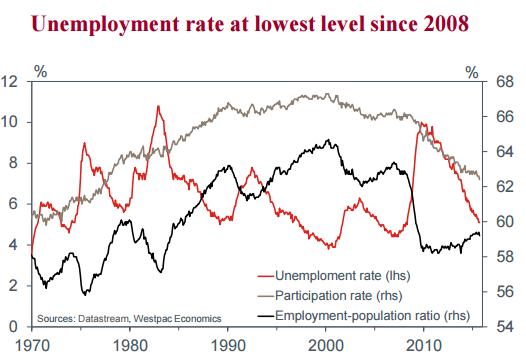The Federal Reserve left short-term interest rates unchanged earlier this week, but clearly highlighted the potential for tightening as soon as the December meeting. The committee made a clear decision to lean hard against the prevailing market view that liftoff would be postponed into 2016. But it is yet to be seen if the Fed's newfound hawkishness will be validated by the economic data.
Policy makers are attempting to force market participants to price the real possibility of a rate hike in December should economic and financial conditions warrant. In order to justify a rate increase, the economy should be sending clear signals that it is ready and able to withstand a rising rate environment. Economic data and the markets will determine Fed action, and Fed officials have plenty of opportunity between now and the Dec 15-16 meeting to decide.
As of now, only a small part USD appreciation has been so far explained by approaching Fed tightening, the dollar has more room to rally when the Fed actually starts hikes. Historic data suggets that the USD usually rallies the 3-6 months into the first Fed hike before depreciating thereafter as other central banks follow suit. But unlike previous cases, most global central banks other than the Fed are in the easing mode at this time. Lack of policy synchronization supports the view that the USD rally we have seen over the course of the past year has room to run.
The policy-related part of the trade-weighted USD index strengthened by about 6% in 2004 when the Fed started hikes in the previous cycle. By comparison, the policy related part of the USD has strengthened by less than 1% this year. Correlation between the dollar and oil prices has declined notably since last year with the 3m correlation reaching -40%. The approach of Fed hikes has had little impact on the oil price so far. However, further strength in the USD along with the expectations of slower US growth on the back of Fed hikes has the potential to put further downward pressure on oil.
"EUR/USD is seen finishing the year at 1.00 where policy divergence is most stark. Any further rally in the dollar also presents downside risks to commodities priced in the USD such as oil", says BoFA Merrill Lynch in a research note.
This time around, while the US Treasuries are offering much lower prices than it did in the last few tightening cycles, the yields on other developed market sovereign bonds are even lower. As a result, the foreign demand for Treasuries will remain high, even when the Fed eventually hikes rates. Back end of the UST curve, has notably flattened recently and attracted some investor attention. The Fed-related part of the 10s30s curve has flattened by about 18bp since last year, about the same amount of flattening seen in 2004.
Policy divergence between Fed and other central banks will continue to be a USD-positive factor

Friday, October 30, 2015 11:14 AM UTC
Editor's Picks
- Market Data
Most Popular
3



 Fed Near Neutral Signals Caution Ahead, Shifting Focus to Fixed Income in 2026
Fed Near Neutral Signals Caution Ahead, Shifting Focus to Fixed Income in 2026  New RBNZ Governor Anna Breman Aims to Restore Stability After Tumultuous Years
New RBNZ Governor Anna Breman Aims to Restore Stability After Tumultuous Years  Bank of Japan Poised for Historic Rate Hike as Inflation Pressures Persist
Bank of Japan Poised for Historic Rate Hike as Inflation Pressures Persist  Canada Stocks Steady as Markets Await Fed and BoC Decisions
Canada Stocks Steady as Markets Await Fed and BoC Decisions  RBI Cuts Repo Rate to 5.25% as Inflation Cools and Growth Outlook Strengthens
RBI Cuts Repo Rate to 5.25% as Inflation Cools and Growth Outlook Strengthens  ECB Signals Steady Rates Ahead as Policymakers Warn of Inflation Risks
ECB Signals Steady Rates Ahead as Policymakers Warn of Inflation Risks  Evercore Reaffirms Alphabet’s Search Dominance as AI Competition Intensifies
Evercore Reaffirms Alphabet’s Search Dominance as AI Competition Intensifies 






























